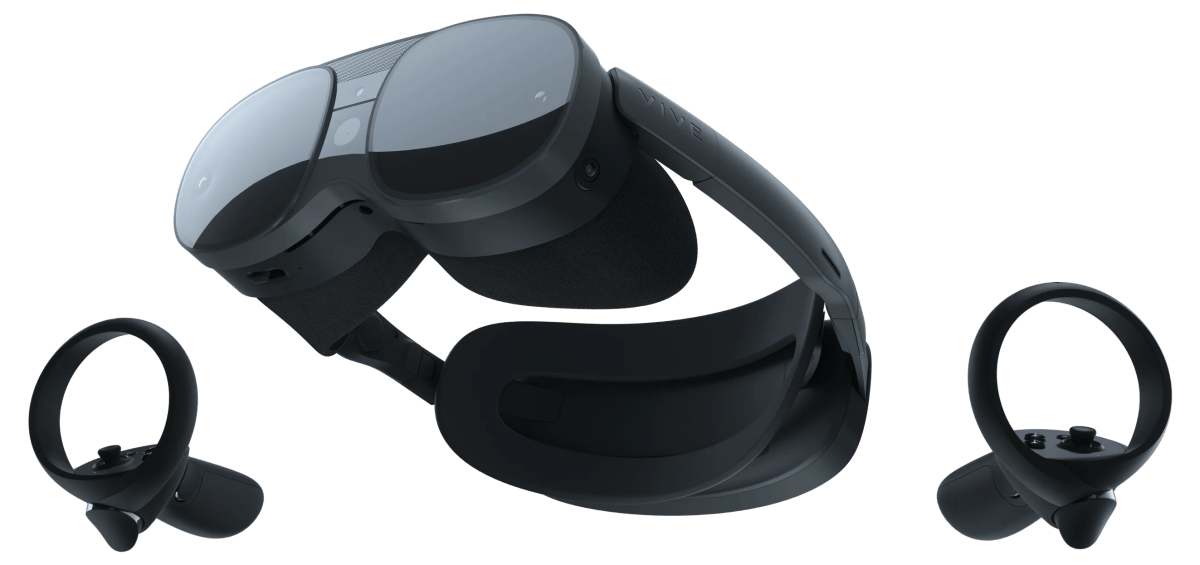A decade has passed since HTC’s mixed reality division broke off from the rest of the company, and in that time, the business has undergone significant changes. It’s no longer appropriate to refer to HTC as a mere phone company – though they do still produce mid-range devices for the Asian market, their “vast majority” of global business now comes from their mixed reality department.
We recently sat down with Dan O’Brien, General Manager of Vive, and John Dabill, Head of Product Operations, at this year’s MWC conference. As usual, HTC has gone all out with their booth – it’s big, white, and scattered with demo stations.
To get to the conference rooms in the back, attendees first have to navigate between a dancing woman and a group of men wielding plastic guns in all directions. Beyond them, various third-party representatives are showcasing their own products, including Nord Space ApS, who helped customize an HTC headset for Danish ISS crew member Andreas Mogensen. The startup’s Chief Technology Officer points out that many tracking systems are affected by gravity, making it a critical factor to consider before spending large sums of money to send technology into space.
Notably, the two front-facing demos are focused on entertainment. Watching someone play a unique dance game is a surefire way to grab the attention of conference-goers, whereas an enterprise training app may not be as eye-catching. However, despite the consumer business’s shrinking presence, it still pales in comparison to the enterprise offerings.
“We used to have a 50/50 split,” says O’Brien, “but now we’re closer to 70% being focused on enterprise.” This shift towards business-oriented ventures has been in the works since Vive’s early days. In 2015, HTC distributed 27,000 headsets to developers in an effort to establish a robust Vive ecosystem. Of that number, around 30% went to enterprise developers. It turns out HTC was ahead of the game, as Magic Leap would later learn the hard way.
“[Magic Leap] was confused about the market’s potential,” O’Brien remarks. “They started with a heavy focus on consumers, even spending $10 million on a content deal, but only launched with 12 pieces of content for a $3,000 headset. It didn’t solve any problems; it was just for entertainment. When you’re competing for people’s leisure time, it’s a tough battle. You’re up against popular consoles like Xbox and PlayStation, not to mention people’s phones. They quickly shifted their focus to enterprise, but even then, it’s a challenging business.”
HTC’s initial emphasis on gaming was partially due to their early collaboration with Valve. When the Vive team first came together, they were working on prototypes for augmented reality. As the parent company of Steam, Valve was a natural choice for HTC to partner with, as they have extensive experience with developers and content – something HTC lacked at the time.
Gaming remains the primary application for the consumer side, but enterprise ventures far outweigh it in terms of revenue. In recent years, HTC’s presence in the headset market has dwindled for most potential buyers. Currently, Meta dominates the field, while Apple’s Vision Pro has recently garnered attention (although it’s debatable if a $3,500 device can be considered a consumer product).
Meta, in particular, has had a significant impact on the industry, influencing how people envision the metaverse. “I think Meta has shifted the market’s perception of how much this technology should cost,” O’Brien observes. “Losing $12 billion per year on a business doesn’t feel like success. In 2021, Mark Zuckerberg himself confirmed that Meta is losing money on its Quest headsets, saying ‘We plan to continue either subsidizing our devices or selling them at cost to make them accessible to more people.'”
O’Brien notes that this only works because Meta has a massive ad business to support their mixed reality endeavors. For the foreseeable future, they will likely continue to lose money on headsets, as they believe flooding the market with devices is essential to their vision of the metaverse. On the other hand, HTC now identifies primarily as an extended reality company. Their revenue comes from headsets, not in spite of them.
Fortunately, HTC recognized the challenges of the consumer market early on, giving them a significant head start ahead of other competitors like Magic Leap.
Training remains the most prevalent application for enterprise ventures. Purchasing multiple headsets at once may require significant initial costs, but in certain situations, companies can save money in the long run. Various industries can see potential benefits from utilizing mixed reality, including aerospace and healthcare. Interestingly, HTC has obtained FDA certification for two of their headsets and FAA clearance for one.
In recent years, Vive has expanded from virtual reality to mixed reality, incorporating passthrough technology similar to what’s found on the Vision Pro. By including elements of augmented reality, a category HTC initially abandoned, they believe this combination of technologies is the way forward for the industry’s future.
“I’ve made it very clear to Magic Leap and anyone else who asks that the future of wearables is a headset capable of VR, mixed reality, and AR,” O’Brien explains. “The argument over who will ‘win,’ AR or VR, relies on the same technology progressing – it’s a silly argument. We’re already seeing mixed reality applications, where people can collaborate in a physical space with a digital overlay of an object. This is just the beginning of mixed reality.”
Meta has also had a significant impact on the industry in another way. When people think of the metaverse, they often envision an AI chat. Facebook has essentially made the two synonymous. However, HTC’s definition of the term is much broader, referring to any virtual space where people with headsets or other technology can connect.
An example of an enterprise application for the metaverse, according to O’Brien, is a meeting he had with Wells Fargo. “They said, ‘We fly 380 people to a town hall meeting in Charlotte every year,'” he recalls. “We told them, ‘With one of these Mars Camtracks, you could have 300,000 people attend instead. You could have invited everyone and paid a couple thousand dollars per person.'”
Like the rest of the world, HTC is currently exploring the integration of generative AI into their ecosystem.
“We absolutely believe it’s coming soon,” Dabill comments. “AI is already helping with 2D images and video at a rapid pace. We’re not there yet, but it will undoubtedly help develop the virtual reality space. You won’t need artistic or technical skills; you can simply talk to the AI and have it create the space for you.”
This type of functionality is expected to arrive in the near future, and it will likely have a significant impact on VR’s ability to generate virtual environments. For example, it may enable the creation of infinite scenery on the fly.








